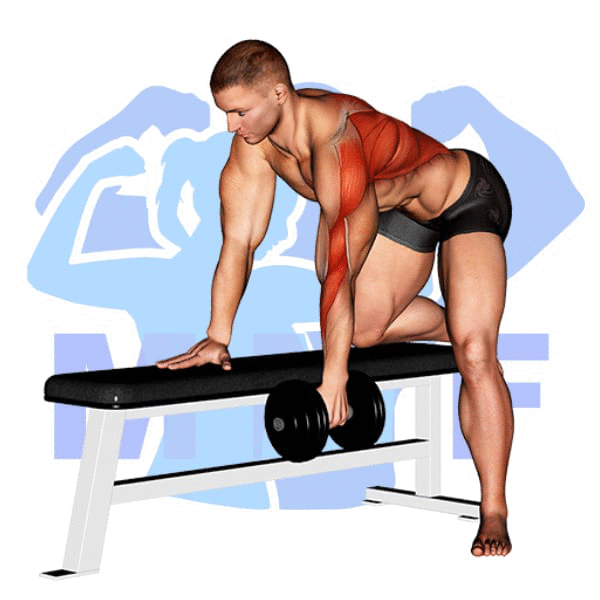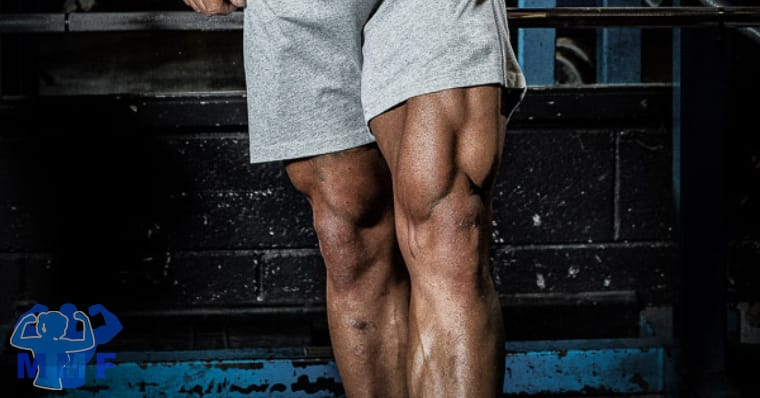The single-arm dumbbell row is a prevalent back exercise. Although it is frequently done wrong and can lead to injury, single-arm rows should be a go-to exercise if you stick to these simple recommendations.
Single-Arm Dumbbell Bent Over Row Summary
- Primary Muscles Worked: Latissimus Dorsi
- Other Muscles (Secondary) Worked: Brachialis, Brachioradialis, Deltoid, Infraspinatus, Rhomboids, Teres Major, and Trapezius.
- Equipment: Dumbbells and Bench
- Mechanics Type: Compound
- Force: Pull
- Utility: Auxiliary
How to Properly Perform Single-Arm Dumbbell Row
The Setup
- Grab a dumbbell and place it on the ground beside a bench.
- Place one knee and the corresponding hand on the bench. You want to adjust your knee and hand so that from your knee to your hip is a verticle straight line. Additionally, from your hand to your shoulder should be a verticle straight line aswell.
- Using your foot that is on the ground, establish a sturdy tripod base to support your weight and the dumbbell.
- Now you can bend down by doing a one are pushup off the bench and pick up the dumbbell.
Executing Single-Arm Dumbbell Row Correctly
- Once you have picked up the dumbbell, you want to lift the dumbbell with your lats.
- To pull with your lats, drag your bicep across your lat on the way up and down. Focus on pulling your elbow straight up.
- Next, lower the weight, stopping before you drop your shoulder, or lock your elbow. If you drop your shoulder, you will be incorporating your posterior deltoid.
- Finally, repeat.

Single-Arm Dumbbell Row Demonstration By Nuffield Health
Single Arm Dumbbell Row | Nuffield Health
The Muscles Used In Single-Arm Dumbbell Row
Target (Agonist) Muscles
- Latissimus Dorsi
Synergist Muscles
- Brachialis
- Brachioradialis
- Deltoid, Posterior
- Infraspinatus
- Major, Sternal
- Pectoralis
- Rhomboids
- Teres Major
- Teres Minor
- Trapezius, Lower
- Trapezius, Middle
Dynamic Stabilizers Muscles
- Biceps Brachii
- Triceps, Long Head
Stabilizer Muscles
- Adductor Magnus
- Erector Spinae
- Gluteus Maximus
- Hamstrings
Antagonist Stabilizers
- Pectoralis
- Triceps, Long Head
Tips for Better Sinlge-Arm Dumbbell Row Form
- Start With A Strong Base. In every free weight exercise having a strong base is important. For the single-arm row, you will have a strong tripod base with the non-exercise knee and hand on a bench.
- Maintain Good Spinal Alignment. It is very important to have good posture when you are performing the row. In fact, you must maintain both vertical spine alignment and rotational alignment.
- Wear A Lifting Belt. Specifically, if you are having trouble maintaining good posture using a lifting belt will help.
Common Errors While Performing the Bent Over Rows
- Don’t Place Your Stabilizing Arm and Knee To Close. Spreading out your stabilizing leg and arm helps keep your back straight. Therefore you will be less likely to have bad posture and bad form with a longer base.
- Don’t Curve Your Back Up. In other words, don’t slouch. To keep for slouching lift your butt and push out your chest.
- Don’t Over Arch Your Back. Dropping your hips and arching your back too much will shift the exercise to your shoulder.
- Don’t Drop Your Shoulder. When you drop your shoulder at the bottom of the row you are incorporating your posterior deltoid. Although this might not be a bad thing, the problem comes in rotation. Understandably, when you rotate your spine underload you are opening your self up for injury.
Jeff Cavaliere On Fixing Your Single-Arm Dumbbell Row
Stop Doing Dumbbell Rows Like This!
Single-Arm Dumbbell Row Variations
Here are some variations to rotate into to your training regime. Check out our exercise category for more alternatives.
Exercises To Compliment Your Single-Arm Row
Strengthening Your Back And Adding Rows To Your Training Regime
Remember whatever exercise you do to strengthen your back, ensure you have proper form. For more back exercises check out 7 of the Best Exercises for Strengthening Your Back.




